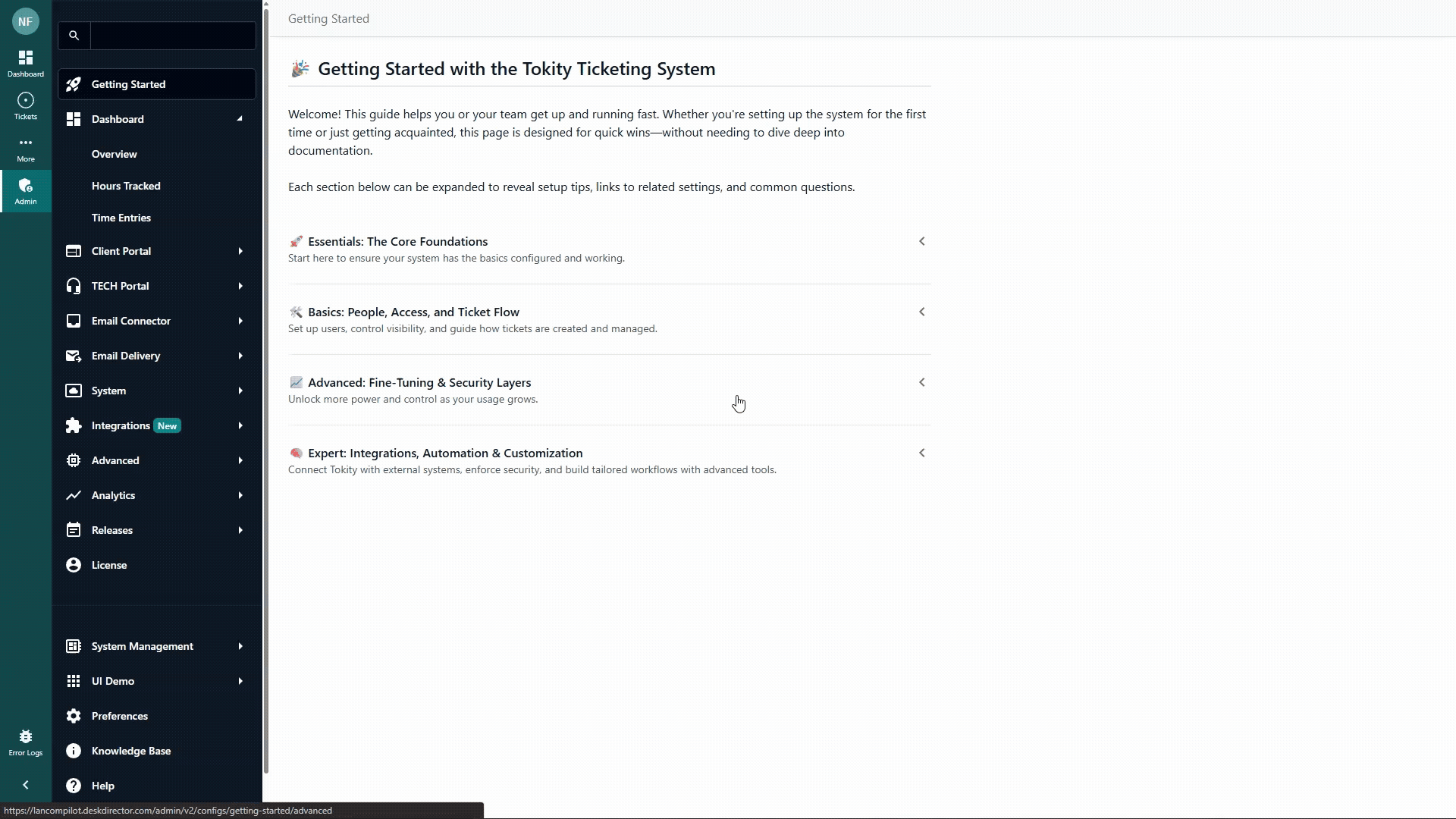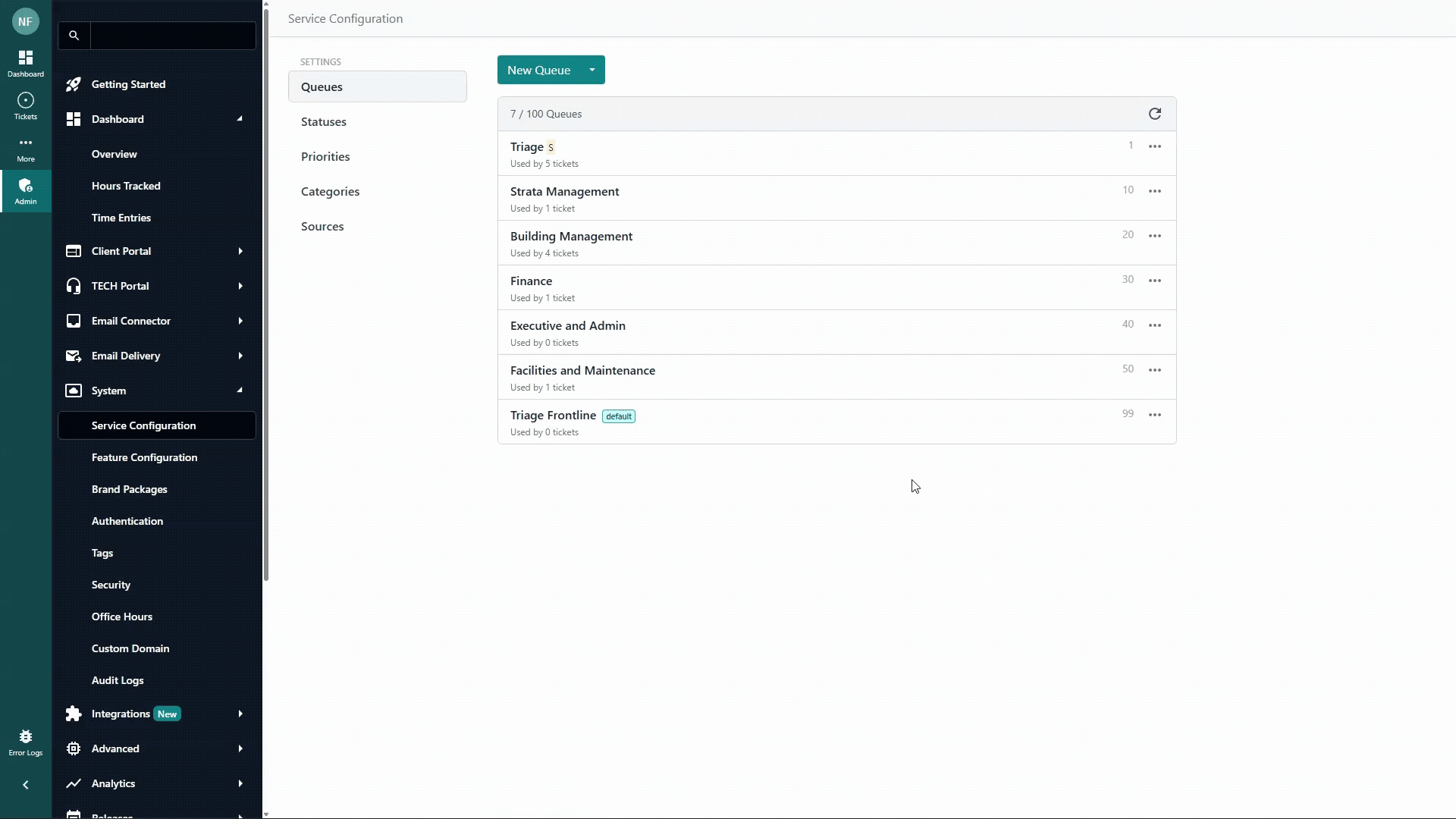Table of Contents
Permissions & Feature Configuration (Tokity)
 Updated
by Niamh Ferns
Updated
by Niamh Ferns
Service Configuration
Service Configuration is where you set up your queues, statuses, priorities, categories, and sources. In comparison to using DeskDirector with a PSA integration, our Tokity backend allows you to configure these directly within the Admin Portal.

Service Configuration Settings
Under the Service Configuration tab, you can configure:
- Queues: These are analogous to boards and queues in other PSAs. They provide a centralised place for tickets to be viewed related to a specific area (e.g. development, triage, finance, etc).
- Statuses: These are the different statuses that a ticket can be in and represent the different stages of a ticket's lifetime from ticket creation to final resolution and closure.
- Priorities: These allow you to decide and represent how urgent a particular ticket is.
- Categories: These provide another way for you to further narrow down on tickets for a particular board (e.g. you may have development tickets with categories for bug fixes, new features, QA, and feature requests).
- Sources: These allow you to show where a ticket originated from (i.e. an email, from your DeskDirector Client Portal, from an Automation, and more).
You can create a new service by clicking on its relevant New Service Item button. For example, below you can see an example for creating a new Queue:

Feature Configuration
You can configure the various features for DeskDirector at a global level in the Admin Portal under System > Feature Configuration.
Ticket Approval
Under the Ticket Approval section, you can configure the Ticket Approvals. Specifically, this is where you can view your approval statuses for tickets that are pending, approved, or declined. You can also configure automatic approvals for users who have either approval or VIP permissions granted.

Ticket Actions
The Ticket actions section is where you configure what happens to your tickets that are escalated, fast tracked, reopened, closed, or have been updated by an end user. This section also allows you to disable or enable fast tracking, escalation, and reopening of tickets globally.

VIP
The VIP section allows you to enable or disable the VIP system globally. When enabling VIP, tickets that are submitted by a user marked as a VIP will automatically have the VIP priority, regardless of what your Service Type is set to use as a default. This is useful for prioritising tickets by important contacts of your clients.

Advanced Feature Configuration
Under the Advanced tab, you can add a URL to be used globally for dynamic content. We won't go further into this here as it's an in-depth topic, but you can read more in our article on Dynamic Ticket Content.

End User Permissions
Permissions in DeskDirector follow a system called Cascading Override. That is, your permissions go from the widest scope (Globally Scoped) to the narrowest scope (User Scope), where narrower scopes will always overwrite a wider scope.
If you then set a user under that company to override the company setting and again disable Fast Track, that specific user will have Fast Track disabled regardless of the company-specific settings.
This is important to understand when troubleshooting common issues in DeskDirector for your end users.
Once you've set up your global permissions, you can start narrowing down which users should have access to specific features. Our recommendation here is that you follow the principle of least privileged access. That is, global settings are more restrictive and advanced or more powerful features should be restricted to specific Accounts and then Contacts, respectively.
Global Settings
Global settings can be configured under Client Portal > Global Settings. You will have access here to configure the general features, global portal menu, and global service group for all contacts and accounts in your DeskDirector instance.

You can also set a global baseline for what Queues and tickets should be accessible to your Accounts, Contacts, and Agents:

Account Permissions
Account permissions can be changed in the Admin Portal under Client Portal > Accounts > {Account}.

You can fine tune permissions for a specific account for:
Queues and tickets
- Ticket Sharing: Whether users of this Account should be able to view all tickets that are under that Account (i.e, some user A will be able to see some user B's tickets if they are contacts under the same Company Account):

- Queue Access: Which queues the company is allowed to see tickets in:
 Note: if a Service Type sets a ticket to land on a queue the contact/account doesn't have access to, the contact will not be able to access their ticket.
Note: if a Service Type sets a ticket to land on a queue the contact/account doesn't have access to, the contact will not be able to access their ticket.
Features - General
- Features: settings to toggle/set whether an account can access the Client Portal, Learning Center, Ticket Chats Feature, or whether they're allowed to attach screenshots to a ticket.

- Ticket Actions: set whether the user is allowed to fast track or escalate their tickets.

- Request Support: set what means are available to a user for requesting support (chat callbacks, pre-ticket chats, or use the "Something Else" support option).
 Please note that these settings cannot be set for specific contacts and can only be configured at an account level.
Please note that these settings cannot be set for specific contacts and can only be configured at an account level.
Features - Custom Portal Menu
Here, you can set a custom menu to appear for all contacts under this account.

Features - Service Group
Here, you can set a Service Group to use for all contacts under this account.

Contact Permissions
Account permissions can be changed in the Admin Portal under Client Portal > Contacts > {Contact}. You can fine-tune permissions for a specific account for:
Queues and tickets
- User Role: allows you to set whether this user is a manager (VIP) and whether they're allowed to Approve or Decline Approvals:

- Queue Access: Which queues the contact is allowed to see tickets in:
 Note: if a Service Type sets a ticket to land on a queue the contact/account doesn't have access to, the contact will not be able to access their ticket.
Note: if a Service Type sets a ticket to land on a queue the contact/account doesn't have access to, the contact will not be able to access their ticket.
Features - General
- Features: settings to toggle/set whether an account can access the Client Portal, Learning Center, Ticket Chats Feature, whether they're allowed to attach screenshots to a ticket, or use the ticket chats feature.

- Ticket Actions: set whether the user is allowed to fast track or escalate their tickets.

Features - Custom Portal Menu
Here you can set a custom menu to appear for this specific contact.

Features - Service Group
Here you can set a Service Group to use for this specific contact:

Agent Permissions
Agent permissions can be configured in the Admin Portal under TECH Portal > Agents > {Agent}. You can fine-tune Agent access for:
- Queue Access: which queues the Agent is allowed to work on:

- Account Access: which accounts the agent is allowed to work on tickets for:

- Category Access: which categories the agent is allowed to work on tickets in:

Roles
You can change an agent's role under their profile tab by clicking on the little three dots in the top right-hand side, then clicking edit.
Role Table
Access to most features and settings in DeskDirector is controlled via member/resource roles and permissions set for them. In this KB, we detail the specific permissions set for every DeskDirector role.
Agent | Advanced Agent | Admin | Master Admin | ||
Ticket Surveys | View | ✓ | ✓ | ✓ | ✓ |
Update | X | X | ✓ | ✓ | |
View own results | ✓ | ✓ | ✓ | ✓ | |
View all results | X | X | ✓ | ✓ | |
Custom Surveys | View | ✓ | ✓ | ✓ | ✓ |
Update | X | X | ✓ | ✓ | |
View results | X | X | ✓ | ✓ | |
Broadcasts | Create | X | ✓ | ✓ | ✓ |
Service Radar | View analytics | ✓ | ✓ | ✓ | ✓ |
Admin basic settings | Home | X | X | ✓ | ✓ |
Portal | X | X | ✓ | ✓ | |
Analytics | X | X | ✓ | ✓ | |
Releases | X | X | ✓ | ✓ | |
Admin Advanced Settings | Tech | X | X | X | ✓ |
System | X | X | X | ✓ | |
X | X | X | ✓ | ||
Integration | X | X | X | ✓ | |
Advanced | X | X | X | ✓ | |
Account | X | X | X | ✓ | |
Companies | Create | X | X | X | ✓ |
Delete | X | X | X | ✓ | |
Get | X | X | ✓ | ✓ | |
Update | X | X | ✓ | ✓ | |
Contacts | Create | X | X | ✓ | ✓ |
Update | X | X | ✓ | ✓ | |
Portal Settings | Get global settings | X | X | ✓ | ✓ |
Update global settings | X | X | ✓(2) | ✓ |
